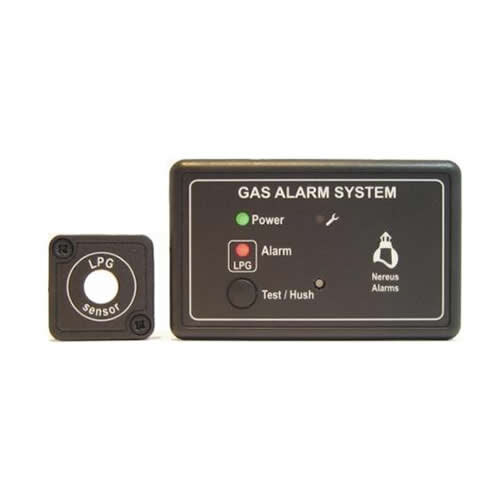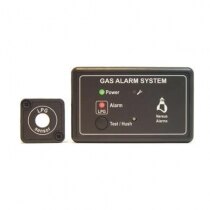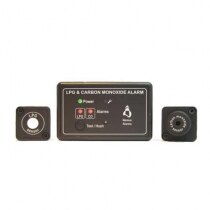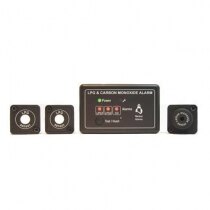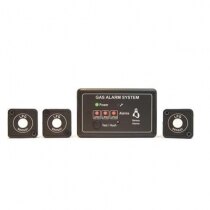-
Contact
Sales & Customer Service
0800 612 6537 support@safelincs.co.uk Live ChatDelivery Enquiries
0800 077 6149 - Resources
Fire & Safety Solutions
CALL OUR TEAM NOW 0800 612 6537
Lines open today 8:30am - 5pm
Quick Delivery
From £6.19 inc VAT
Live Chat - Online
Instant help & Advice
Trade Discounts
and exclusive pricing
0% Credit Available
Open an account now
5 Star Customer Feedback
Nereus LPG and Carbon Monoxide Gas Boat Alarms
Product Overview
Benefits
Options
Technical Data
The Nereus gas alarms range are designed for boats, such as yachts and narrow boats, but can also be installed wherever waterproof sensors and a remote warning are required. The waterproof LPG (butane/propane) and CO (carbon monoxide) detectors give you sufficient warning should there be a gas leak or carbon monoxide present (different sensors) by sounding a buzzer and shining a red light on the control unit. Select a control unit with different quantities and types of sensors. The sensors can be fitted either flush or surface mounted and should ideally be located 300mm up from the floor. The sensors are interlinked by cable with the central monitoring unit.
- Power: hardwire 12/24V DC
- Sensors available for LPG (butane/propane) and CO (carbon monoxide) detection
- Unique waterproof sensor – The sensors are able to survive being completely immersed allowing them to be mounted low in the bilge
- Sensors comply to:
- IP55 – Dust and Water Jetting
- IP57 – Dust and Immersion
- Easy to install
- Sensor cable length 6m
- LED power and alarm status indicators
- Internal alarm and output to drive additional remote alarms
- Relay output can connect to gas shut off or control systems
Detect Gas in the Bilge
LPG (butane/propane) is used extensively on boats to provide fuel for cooking and heating. Being heavier than air, any leak of gas will sink and can collect in the boat from the bilge upwards. A naked flame or a spark from an engine or switch is all that is required to cause an explosion.
Carbon Monoxide (CO) is the poisonous gas formed when fuels such as LPG, petrol, or charcoal are burnt. A faulty appliance or adverse weather conditions can quickly result in a dangerous build-up. Carbon monoxide has no smell or taste and is invisible to the naked eye, therefore an electronic sensor is the only reliable way to warn or this potentially fatal gas build up.
The Usual Problem – Water Damaged Sensors
The problem is where to site the sensors. A sensor mounted anywhere in the bilge is prone to water damage. This is especially the case, when mounted low in the bilge, ie where it needs to be fitted. Once wet, traditional sensors are permanently damaged and can give a continuous false alarms. This leaves the crew unsure how to act, not knowing, whether the alarm is due to a gas leak or damaged sensor. Apart from the inconvenience, this results in expensive repair and a period without protection.
The Solution – Unique Waterproof Sensor
Nereus LPG and CO sensors are able to survive being completely immersed, allowing them to be mounted low in the bilge without the risk of water damage.
Nereus Alarm Specification
| Alarm Sensitivity | LPG: ~10% LEL (lower explosive limit) |
|---|---|
| Carbon Monoxide: 50ppm / 100ppm / 300ppm | |
| Operating Voltage | 12V / 24V DC (10V to 32V DC) |
| Temperature Range | -10°C to +40°C |
| Alarm Relay | NO or NC, non-latching, 24V 1A contact rating |
| Dimensions (HxWxD) | Control unit: 96 x 59 x 26mm |
| Sensors: 35 x 35 x 26mm |
Nereus Alarm Variations
| Model | Sensor 1 | Sensor 2 | Sensor 3 |
|---|---|---|---|
| WG100-L | LPG | — | — |
| WG200-LL | LPG | LPG | — |
| WG200-LC | LPG | CO | — |
| WG300-LLL | LPG | LPG | LPG |
| WG300-LLC | LPG | LPG | CO |
| Product Code |
with 1x LPG Gas Sensor WG100-L: NAWG100-L with 2x LPG Gas Sensors WG200-LL: NAWG200-LL with 1x LPG and 1x CO Sensors WG200-LC: NAWG200-LC with 3x LPG Gas Sensors WG300-LLL: NAWG300-LLL with 2x LPG and 1x CO Gas Sensors WG300-LLC: NAWG300-LLC |
|---|---|
| Brand | Nereus alarms |
| Alarm Relay | NO or NC, non-latching, 24V 1A contact rating |
| Alarm Thresholds | LPG: ~10% LEL (lower explosive limit) CO: 50ppm / 100ppm / 300ppm |
| Dimensions (HxWxD) | Control Unit: 96 x 59 x 26mm Sensor: 35 x 35 x 26mm |
| Operating Voltage | 12V / 24V DC (10V to 32V DC) |
| Temperature Range | -10°C to +40°C |
| Weight | NAWG100-L: 0.6kg NAWG200-LL: 0.62kg NAWG200-LC: 0.62kg NAWG300-LLL: 0.65kg NAWG300-LLC: 0.65kg |
| Product Datasheets |
Pricing & Availability
| Model | Stock | Price |
|---|---|---|
|
with 1x LPG Gas Sensor WG100-L Product Code: NAWG100-L |
Stock Level:
2 in stock Expected dispatch: 16th Dec
|
Price:
£312.95 inc VAT £260.79 ex VAT |
|
with 2x LPG Gas Sensors WG200-LL Product Code: NAWG200-LL |
Stock Level:
Available for pre-order Expected dispatch: 19th Dec
|
Price:
£396.95 inc VAT £330.79 ex VAT |
|
with 1x LPG and 1x CO Sensors WG200-LC Product Code: NAWG200-LC |
Stock Level:
2 in stock Expected dispatch: 16th Dec
|
Price:
£396.95 inc VAT £330.79 ex VAT |
|
with 2x LPG and 1x CO Gas Sensors WG300-LLC Product Code: NAWG300-LLC |
Stock Level:
Available for pre-order Expected dispatch: 19th Dec
|
Price:
£503.75 inc VAT £419.79 ex VAT |
|
with 3x LPG Gas Sensors WG300-LLL Product Code: NAWG300-LLL |
Stock Level:
Available for pre-order Expected dispatch: 19th Dec
|
Price:
£506.75 inc VAT £422.29 ex VAT |
Delivery Options
The following delivery options are available on this product.
Customer Reviews
1 customer has given this product an overall rating of 5 out of 5
Reviews by real customers
All of our product reviews are written by real customers that have purchased this product from us and are published without modification.Rating: 5 / 5 Stars
Reviewed by: J H
Best price around Quick delivery and easy to fit.
Published on: 1st October 2022
Looking for more information?
If you have any questions or would like more information about this product you can ask one of our specialists.
Live Chat Available Now
Direct Telephone
01507 464181





















